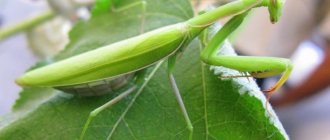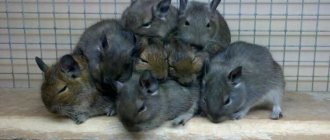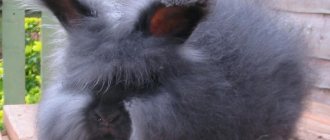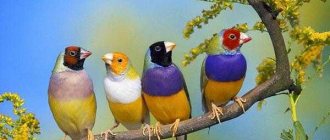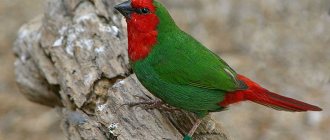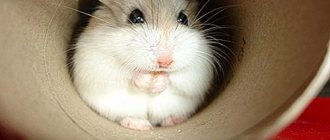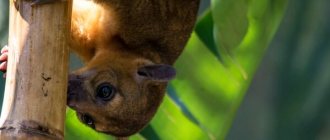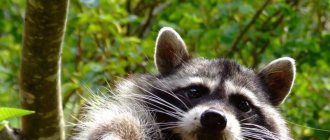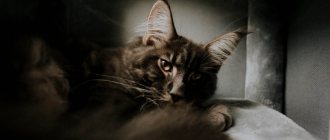Raccoons are incredibly cute and inquisitive animals. They belong to the predatory mammals of the raccoon family. Before getting an exotic pet, owners are first of all interested in how long raccoons live. The lifespan of raccoons depends on many factors. If in the wild the lifespan of a raccoon depends largely on its habitat and climate, then at home everything depends on the owner.
Raccoons are medium-sized predators. Body length from 45 to 60 cm, body weight from 5 to 9 kg. The lifespan of raccoons in the wild averages 2 to 5 years. Some individuals can live up to 10-12 years. Their lifespan at home or in zoos, where they are isolated from natural enemies and also under human supervision, averages 12 to 16 years. Individuals that reach the age of 20-25 years are considered long-livers.
Depending on the type
The raccoon genus includes 4 main species:
- Raccoon The most common species in nature and the most popular among breeders. Includes 22 subspecies, one of which is already considered extinct.
- Raccoon-eater. It got its name because of its diet. In nature, it feeds mainly on crabs and lobsters.
- Cozumel raccoon. A very rare and small species, numbering only about 300 individuals. Distributed on the island of Cozumel in the Caribbean Sea, whose area is only 478 square meters. km. It got its name because of its habitat.
- Guadalupe raccoon. Considered an endangered species. Distributed in the Guadeloupe region of the Caribbean.
Raccoons of all species differ not only in external characteristics (size and weight, color), but also in their habitat. Regardless of their distribution area and other differences, all species have approximately the same life expectancy, about 5 years. In a good situation and favorable conditions, some individuals can live up to 10 years.
All raccoons are excellent tree climbers. They have fairly strong fingers, with which they cling to branches and tree bark. Raccoons are also capable of climbing down trees upside down.
Interesting Facts
Depending on the habitat
Many people are familiar with raccoons from childhood. They can often be seen in cartoons. In real life, raccoons can be found in the Western Caucasus, in the forests near the Kuban River, on the Black Sea coast. You can also often observe the life and behavior of raccoons by visiting the zoo.
The lifespan of raccoons in nature, as mentioned above, is about 5 years. Such a low life expectancy is due to unfavorable weather conditions, various diseases, as well as attacks from other predatory animals.
In zoos or at home, the lifespan of raccoons is much longer, approximately 12 to 16 years. Care, the presence of food and the absence of enemies have an effect.
Video
And finally, an interesting documentary about raccoons.
Author: Pavel Chaika, editor-in-chief of Poznavaika magazine
When writing the article, I tried to make it as interesting, useful and high-quality as possible. I would be grateful for any feedback and constructive criticism in the form of comments on the article. You can also write your wish/question/suggestion to my email [email protected] or Facebook, with respect, the author.
Author page
This article is available in English -
Raccoon.
What affects life expectancy
Many raccoon owners are perplexed why wild raccoons live so short compared to domestic ones. Let's look at what factors influence lifespan:
- Nutrition. In the wild, raccoons are able to independently determine the quality of food and the required quantity. But it is worth considering the fact that these predators are omnivores. They also like to settle in close proximity to humans to raid in search of food. The weak point of raccoons is the digestive system. They often suffer from intestinal problems and can easily become poisoned.
- Natural enemies. Despite the fact that raccoons are carnivorous mammals, they themselves often become prey to larger predators. Their enemies, depending on their habitat, are wolves, foxes, jackals, coyotes, lynxes, lynxes, alligators and even owls. Almost defenseless cubs are often attacked by poisonous snakes.
- Diseases. Raccoons are quite viable animals. They have excellent immunity, which is why their body is immune to many diseases. However, this does not prevent them from being carriers of these diseases.
Interesting! If a raccoon cannot run away or hide from an enemy, then it pretends to be dead!
Humans are also helping to reduce the number of raccoons. In some countries, the raccoon is considered a commercial species. For hunters and poachers, the raccoon is a valuable fur-bearing animal. Its fur is highly valued. Raccoons are also considered pests. They often raid fields and farms, which is why they are exterminated en masse.
Security Considerations
Raccoons are considered the main carriers of rabies. Key symptoms of frantic behavior include:
- Erratic walking
- Lack of response to nearby noise or movement
- Discharge from the eyes or mouth
- Wet and matted facial hair
- Repeated high-pitched vocalization
If your pet raccoon exhibits these symptoms, contact your veterinarian or animal control immediately.
Raccoons can become infected with other parasites and diseases. Because they can bite even if unprovoked, they can be dangerous to other pets and family members. Think carefully about whether this pet is right for you.
How to increase your lifespan
It is worth noting that keeping raccoons at home is quite expensive. They also require quite a lot of attention and should not be left unattended for even a minute. Raccoons are not the type of animal that sits quietly in one place. They are always on the move and must be constantly monitored.
Raccoons have a complex character. Most of the time they are friendly and curious animals. However, with age their character deteriorates. They become arrogant, demanding, and sometimes even aggressive. This behavior can also be noted during puberty, when the animal's hormones are raging.
What helps increase lifespan:
- Diet. You need to create the right menu and stick to it. Raccoons are omnivores. They often beg for food, which is strictly forbidden to be given to them. Raccoons have very sensitive digestion. With improper feeding, the intestines are not able to digest certain foods, which causes bloating.
- Amount of food. You should not overfeed a raccoon; this leads to obesity, which significantly shortens its lifespan. Also, do not give your raccoon a lot of sweets.
- Abdominal massage. especially important for individuals under one year of age. After each feeding, it is necessary to massage the stomach, which promotes and improves the functioning of the digestive system.
- Comfortable living conditions. For a raccoon, you need to purchase a spacious cage measuring at least 1 square meter. m. Inside you need to put a house where the raccoon will rest and sleep.
- Vaccination. The first vaccination must be given at the age of three months. Then they put another one upon reaching the age of 1 code. Then vaccination is carried out once a year.
- Walks. Raccoons are very active animals. They expend enormous amounts of energy every day. In the summer, walks in the fresh air are mandatory.
- Examination by a veterinarian. The owner cannot always recognize the symptoms of diseases in a timely manner. Therefore, it is necessary to visit the veterinarian periodically so that you can provide timely assistance to the animal.
Raccoons that live in enclosures on the street, or often take walks, are susceptible to infection with worms, which significantly reduces their standard of living and life expectancy. Affected individuals rarely live more than 5 years. A raccoon can also pick up ticks on the street. Among the thick fur, it is very difficult to immediately notice the parasite. After each walk it is necessary to examine your pet.
Raccoons are amazing and energetic animals. Not only children love them, but adults will not leave them indifferent. Before you get a raccoon as a pet, you need to study all the information about this animal. With proper care and maintenance, a raccoon will live as long as possible.
What to feed
What to feed your pet raccoon? A partially omnivorous raccoon can be fed with the same things it has in its natural environment: these are various berries, fruits, and nuts. In addition, raccoons can be fed with specialized food for cats and dogs, but only premium food. You can give meat and fish, both raw and boiled, the main thing is not too fatty. Chicken, beef, turkey, veal and rabbit are excellent meats for raccoons. Raccoons eat excellent fruits: apples, pears, grapes, bananas, peaches, plums. Vegetables that will be useful to raccoons include: carrots, fresh peas, asparagus, and zucchini.
Habits
Sexually mature individuals lead a solitary lifestyle and gather in groups only during the breeding season. Every night the raccoon goes out in search of food, exploring the area near its shelter. Usually the animal does not move further than 1-1.5 km from the hole.
Raccoons adapt well to new conditions. They often settle in park areas and near populated areas.
KANGAROO
How does it winter
The inhabitants of the southern regions lead a normal life during the winter months. Living in temperate climates, raccoons hibernate during the winter. Its duration depends on climatic conditions: for example, in the coldest Canadian provinces, sleep with short breaks can last up to 5 months.
A peculiarity of these predators is that before the onset of cold weather they look for spacious holes and hollows and hibernate there in groups of several individuals.
Guadalupe raccoons
They are an endangered species. In France, Guadeloupe, as well as in the Lesser Antilles, where this species of raccoon lives, programs are working on their population. These are land animals that prefer to live near bodies of water.
After being awake at night, raccoons spend the daytime in foliage, on tree branches or in the hollows of trunks. Common parameters:
- Weight: 5-13 kilograms;
- Omnivores;
- Mating season: January to March;
- Gestation period: two months;
- Number of cubs: 2-5;
- Body length: from 50 to 60 centimeters (tail length not included).
When a baby raccoon turns one year old, it will be considered an adult.
Author: Anastasia Gerasimova
Author: Alena Zakharova
Raccoon eater
In South and Central America, where the raccoon lives, jungle tracts and swampy areas are most often observed. The external similarity with an ordinary raccoon is that they have a “mask” on the face and a fluffy tail. The difference is that their dimensions are slightly smaller, their body has a more streamlined shape, and their hair is short. These are solitary nocturnal animals that breed in the second half of summer. Most often, a female gives birth to 3 cubs. This type is characterized by the following parameters:
- Weight: 2-12 kilograms;
- How long do raccoons live - 10-13 years;
- Height at withers: slightly more than 20 cm;
- Body length: 40-60 centimeters (the length of the tail is additionally measured, which is 20-40 cm).
Crustaceans does not mean that the animal’s diet consists exclusively of crustaceans. They are omnivores. The presence of crabs and crayfish in the diet is determined by their presence in the raccoon habitat.
Author: Mikhail Reshetov
Author: Dmitry Ryabov
Author: Mikhail Reshetov
Description and features
An animal with a dense body, up to 70 cm long, has a luxurious tail with lush hair. The weight of the animal is 8-12 kg. Males are a third heavier than females. A natural decoration is a gray-brown fur coat with long hair. The sides and back are darker in color than the yellow-gray chest and belly.
Black and gray rings on the tail are an indispensable attribute of his outfit. The fur sparkles in the sun. The thick skin serves as protection against insect bites.
Previously, the raccoon was considered a distant relative of the bear.
On a wide head there are small rounded ears. The pointed muzzle with dark, beady eyes reflects natural curiosity. Around the eyes there is a black mask framed by light rings, a dark stripe runs from the frontal part to the tip of the nose.
Bunches of vibrissae on the head, chest, and abdomen provide the animal with confident orientation even in complete darkness. Animals receive basic information through touch.
The raccoon's limbs are short. Paws with developed toes, very mobile and tenacious. When walking, the shape of the footprints left resembles a human palm print. The non-retractable claws are sharp, the soles of the paws are leathery. The animal walks carefully, quietly, relying only on its toes, and stands completely on its sole only in an upright position or in a relaxed state.
Raccoons have exceptional grasping abilities
The paws are so agile that the animal can easily wash itself with them, hold objects, rinse them in water, and carry objects to the right place. Pets are able to open doors and inspect closets.
The structure of the animals' feet allows them to turn 180° - a unique ability that allows raccoons to climb trees, climb to impressive heights, and go down tree trunks upside down. Raccoons are often seen hanging upside down from trees.
Many peoples call the animal a rinse bear for its fluffy coat and ability to rinse everything in water. Night vision is characteristic of predators that are awake in the dark. Raccoons have many natural enemies. Danger threatens them from lynxes, wolves, jackals, snakes, crocodiles, owls, and large dogs.
Raccoons are brave fighters, but in an unequal fight the animal pretends to be dead, showing natural cunning.
The fluffy beauties are valued for their fur and are considered a commercial species; some peoples consume animal meat. Increasingly, raccoons are being purchased for home keeping, as the animals adapt well and become friendly pets, although very mischievous.
Vaccination
Every pet, regardless of nature, gender and affiliation, undergoes a course of vaccinations. Raccoons are no exception. There are a number of dangerous and most common diseases. That is why all vaccinations must be done in a timely manner.
The very first vaccination is prescribed at three months of age after treatment for worms has been completed. The second vaccination is carried out upon reaching one year of age.
Veterinarians recommend vaccinating your pets every year. If all procedures are done on time, life expectancy will increase to 7 years.
Cozumel raccoon
The island of Cozumel in Mexico, where raccoons live, has many mangrove and rain forests, as well as beaches suitable for habitat. Brief information:
- Body length: from 60 to 80 centimeters, of which about 25 is the tail;
- Weight: from three to four kilograms;
- Omnivores, half of the diet consists of food of animal origin;
- Color: gray-brown with a yellow tint on the tail.
Red raccoon is one of the variations of the name of the red panda. This is due to the external resemblance to raccoons and the red, or slightly brown, color of the animal’s coat.
